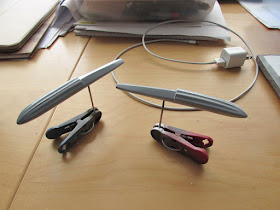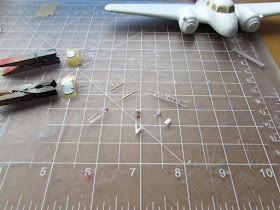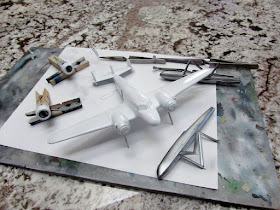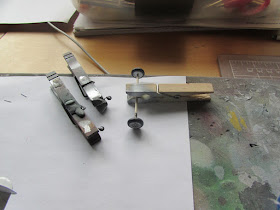A 1937-born Barkley-Grow T8P-1, of course!
(this is the construction article, for the completed model please go here:
https://wingsofintent.blogspot.com/2018/04/barkley-grow-t8p-1-modified-execuform.html
(this is the construction article, for the completed model please go here:
https://wingsofintent.blogspot.com/2018/04/barkley-grow-t8p-1-modified-execuform.html
Continuing with the vacuum-formed building trend, here is a
product from Execuform, that gives you the basic shapes as a sort of base onto
which you have to add the detail you want. Only the main shapes come in the kit
with some leaflets containing a plan, images and information. The decals and
accessories (engine, wheels, cockpit and cabin detail) are to be provided by the
modeler. I have built products from this brand before and they should be
considered a white canvas onto which you can express your modeling artistry, on
subjects most of the time nowhere to be found as injected or resin kits. If do
some scratch-building, Execuform saves you a lot of time by producing the
masters and pulling the styrene shells, but they are not meant as complete
kits.
The Barkley-Grow was not a particularly successful design,
although it managed to operate with a number of airlines and private owners.
Three airframes seem to be still today being exhibited at museums.
The Barkley-Grow was operated on wheels, skis and floats,
making it especially useful as a bush plane in Canada,
where it saw a bit of recognition, negated to it in the US.
The seaplane version had an additional, smaller, central
vertical stabilizer. The land version had a fixed landing gear with
characteristic pants.
Of pleasant lines and uncomplicated design, especially on
wheels, it makes a good candidate to try your skills at this somewhat neglected
media. It teaches you in the process quite a bit.
Notable operators were Canadian Pacific, the US Antarctic
Service, Yukon Southern Air Transport, Pacific Western, Northland, Prairie
Airways, Associated Airlines, a private individual: Alexander Papana (YR-AHA,
Trăiască Regele "Long Live the King", same exact registration by the
way wore by Papana's Bellanca 28-92 trimotor), and the Peruvian government
(OB-GGK, Cruz de Chalpón).
This is what you get in the Execuform package. The basic shapes and reference material:
Outlines with a permanent marker to easily located the edge of the parts:
Parts off the backing sheet (keep the scraps. they will be used later):
Parts sanded up to the line previously traced:
Excursion to the spares bin and aftermarket parts drawers to find engines, props, wheels, etc.:
Separating the future cowls:
Gluing the cowl and float halves (not sure yet if I will present the model on floats are panted wheels):
Floats and cowls with a cursory tide-up (notice the roundish stern on the floor, that has to be sawed off:
Stern sawed off to real shape (the floats are a few millimeters longer to allow you to do this):
Float noses also come with the kit, in case you feel you need them to achieve a better shape -or mess-up):
The kit provides cowl fronts:
Carburetor intakes from unknown donor. As they are hollowed and firm in the drill bit, the mold edges are cleaned up:
Just in case the struttery for the floats is being prepared (I WANT MORE CONTRAIL AEROFOIL MATERIAL!!!!):
Inner "N" float struts assembled. Passenger seats scratched, pilot-copilot seats and control wheel from spares box:
Remember I said do not discard the scraps? here a cockpit/cabin floor is made of from a piece:
Dry run of the setup:
To deal with the roundish (inaccurate) finish of the float step, a cut is made:
A styrene sheet piece is inserted in the cut with glue:
So the blobby area can be later on removed:
The float bottom flutes will have to be "sharpened" a bit using sandpaper wrapped on a dowel of appropriate diameter.
After the glue has set, then you can cap the stern:
The tail surfaces have to be thinly sanded, without excesses. The two parts on the left still need some thinning down:
Correct sanding is the clue to any vacuum-formed model:
Pants are separated:
Using a contour gauge the bulkheads are made from the scrap plastic. Some of the halves are glued together. Demarcation of windows and doors begins. Separation lines for all control surfaces will have now to be engraved. The tail has a complex assembly, and that will have to be taken care of too:
The pants are opened at the bottom to slide the wheels in:
The Aeroclub Wasp Junior is a perfect fit to the cowl:
I continue to build the fixed landing gear and the float version, just to give an idea of the process for not so experienced modelers, but I think I almost made my mind on seaplane "Belvedere", which eventually became one of the museum airframes.
Belvedere (CF-BQM) had a blue fuselage and white flying surfaces and logo, with the floats in NMF.
My other options were also a seaplane flown by Pacific Western, with and attractive scheme, and a more traditional Canadian Pacific machine on wheels, just because long time ago my grandfather flew Canadian Pacific from Argentina to the US.
Here the cowls are dry-fitted to the nacelles. So far, if you did things right, the fit is good and the outlines are correct:
Work continues on the floats:
Belvedere had its intakes on the exterior upper quarters of the nacelles, the usual lower intake being absent.
I made the intakes already for the land version, and here the other ones are being made from a sprue leftover, first heating and bending (be careful):
Then cutting off the elbows:
Then flattening the area closer to the nacelle (base of the intake mouth), and later carefully hollowing out the intake a bit:
The trailing edges of the cowls are now carefully and gradually thinned, just at the edge, to convey the appearance of metal sheet:
Modelers know that appearances can be deceiving, and if it is true that all main parts seem to be there, is the details that take a lot of the building time.
Here are the rudders for the floats, and metal pins being glued to the main float strut legs:
Now is a good time to look for things that need to be drilled, patched, reinforced, etc, before the parts are put together. In this case the holes for the exhaust tubes:
The kit presents a conundrum, since the aft-wing surface is represented both in the fuselage and the wing itself. You can't just glue to wing on, the area becomes way too thick, so one has to go. I opted for trimming the fuselage bit, since it was thick anyway:
Dry fit:
Piece for repair:
Now, after all those openings...
First the opening are drilled, then, VERY CAREFULLY, enlarged using other bits on the Dremel, step by step...
Maintain symmetry where needed:
Hand tools are better for the final approach:
Mold blemish, perfect to show that there are solutions for most things (like the little triangular bit above to patch the fuselage bottom too large cut):
Thin part fabricated to reinforce the area from the interior:
Glued on:
The little Milliput patch, later to be sanded to shape:
State of the Union of Parts, or Barkley-Grow Commonwealth:
The floats are given a coat of primer to detect blemishes:
The instrument panel is cut:
The landing gear legs (not the version I intend to build) had sleeves, so these are fashioned from a thin styrene strip:
Once the glue sets the remainder will be cut off:
The patch on the mold ding worked out well:
Cargo area being detailed with bulkheads and stringers:
Cockpit/cabin pan being detailed:
Using the fuselage halves themselves, the contour of the doors is traced from inside onto a piece of styrene sheet:
The doors are cut and bent:
And then "hinges and handles" are added from stretched sprue. These will be lightly sanded to make them rounder at the end that fits the part, but the stalks will be only cut to size after painting, to facilitate handling:
A couple more elements added to the cockpit:
The hatch for the cargo hold is carved:
Tabs are secured to help alignment, increase gluing surface and add rigidity:
Now dealing with engraving the control surfaces. The tail presents a little dilemma. The fin/rudder separation line on the vertical stabilizer is not continues, but, besides a balance mass, has a receding line under the stab.
Furthermore, the rudders are "inserted" on the stab, whilst the fins divide in upper and lower halves. Summarizing: you can either cut the stab tips to add the vertical stabilizers, of you have to cut the latter.
I opted for the second option, also separating fin and rudder. This will give us at the beginning fours parts, but the rudder upper and lower sections will be glued, as per original, at their trailing edge. You will have to study photos of the original plane to decipher what I am talking about:
The upper and lower rudder will later be "reunited" at their trailing edges. As you can see, the rudder "flies" over a fixed section of the stab:
The first move is to separate upper and lower halves, then carve the curve to follow -always checking as you go- the airfoil of the stab:
The reinforcements at the exterior side of the nacelles -a la DC3- cover in the original wing external panels joint. I used the smallest section of semi-circular styrene rod:
The interior is given the first color:
Reinforcement battens are added to the floats as per photos, the trolley wheels holes drilled:
A second and third color are airbrushed:
Details will be picked up by hand now:
The Aeroclub engines as said before are a perfect fit for the cowl, but the sub-assembly needs a separator to generate the right distance to the nacelle, so discs of styrene are prepared, to connect the firewall to the back of the engines (leaving a necessary gap between cowl and nacelle):
Tail is assembled. The central fin is a bit roundish in the kit, but photos show that its LE and TE were straight, so the part is accordingly easily reshaped, and given the "tail-up" cut to clear the "elevator up" position:
Slightly oversized pieces of acrylic are cut, then shaped to fit the particular window, one by one:
Once fitted, they are removed, aligned to follow their respective positions, and one by one bathed in floor polish, excess removed on a piece of card, and let to rest leaning on a surface.
Once dry, they will be positioned on the model, and very carefully given a very thin touch in the borders with low density cyano, letting it run the seam.
Once set, the windows will be masked on the outside, and the fuselage sides glued together. It just tired me of writing it!
The curtains are added:
Ready to proceed:
Fuselage halves glued together; the exhausts are given pins to secure them on the fuselage bottom as per photos:
The yawning gaps and not so good fit called for drastic modeling action, so 10 min. epoxy had to be used to glue the wing to the fuselage, giving plenty of time to make adjustments and material to fill the enormous gaps:
Here Milliput, as said above, was added on top of the wing/fuselage joint.
Normal putty is on the seams elsewhere. All that of course has to be sanded to proper contour.
A cut is made to lodge the stab:
And the stab glued in place, taking care of allowing a theoretical elevator down movement.
Next to central fin is going to be glued, but after I tidy the seams in the area.
At this point, will all the putty, is when models don't look really appealing.
A little bit strange, but the B-G (or at least Belvedere) had the bottom of the floats painted red (red underfloats, as they are known in the Ornithopter modeling community).
At this point engines are given a base coat of black paint, and prop tips are painted yellow as per photos:
Ready for the first coat of primer:
Antennas, scoops, beacon, etc., being prepared:
Ladder that goes from float to door also built at this point:
The primer revealed as usual a couple of spots that need attention:
Several cleats are made to chose the better for the floats:
The red under the floats is masked to apply the black color for the Alclad:
The white color is applied to the fuselage and engine cowls.
This will be partially masked to apply the blue color eventually.
Aluminium color is applied to floats, float rudders, and ladder:
The bottom of the floats is unmasked to reveal the red color:
I had forgotten the faired scissors linkages under the wing, so I made the five pairs that decrease in size towards the tip:
The decals from Arctic Decals arrived!:
The model is masked to be able to paint the blue color:
The details on the spine are added:
The blue color is applied:
The round lids made of punched alu sheet are glued in place on the floats.
Still to add are the mooring cleats and succinct rudder rigging, plus painting the nose black:
Et voilà:
The floats are added. No small task to glue and align them:
Exhausts made of alu tube:
Getting closer to completion:
Little by little all the bits are added. Ladder, engines and cowls, floats' rudders:
The float tips are painted black
The fairings of the scissor links under the wings and decals:
Mooring cleats, boomerang antenna, spine antenna, props, rigging for the floats' rudders:
Preparing parts for the beaching gear:
To be continued.....
The landing gear legs (not the version I intend to build) had sleeves, so these are fashioned from a thin styrene strip:
Once the glue sets the remainder will be cut off:
The patch on the mold ding worked out well:
Cargo area being detailed with bulkheads and stringers:
Cockpit/cabin pan being detailed:
Using the fuselage halves themselves, the contour of the doors is traced from inside onto a piece of styrene sheet:
The doors are cut and bent:
And then "hinges and handles" are added from stretched sprue. These will be lightly sanded to make them rounder at the end that fits the part, but the stalks will be only cut to size after painting, to facilitate handling:
A couple more elements added to the cockpit:
The hatch for the cargo hold is carved:
Tabs are secured to help alignment, increase gluing surface and add rigidity:
Now dealing with engraving the control surfaces. The tail presents a little dilemma. The fin/rudder separation line on the vertical stabilizer is not continues, but, besides a balance mass, has a receding line under the stab.
Furthermore, the rudders are "inserted" on the stab, whilst the fins divide in upper and lower halves. Summarizing: you can either cut the stab tips to add the vertical stabilizers, of you have to cut the latter.
I opted for the second option, also separating fin and rudder. This will give us at the beginning fours parts, but the rudder upper and lower sections will be glued, as per original, at their trailing edge. You will have to study photos of the original plane to decipher what I am talking about:
The upper and lower rudder will later be "reunited" at their trailing edges. As you can see, the rudder "flies" over a fixed section of the stab:
The first move is to separate upper and lower halves, then carve the curve to follow -always checking as you go- the airfoil of the stab:
The reinforcements at the exterior side of the nacelles -a la DC3- cover in the original wing external panels joint. I used the smallest section of semi-circular styrene rod:
The interior is given the first color:
Reinforcement battens are added to the floats as per photos, the trolley wheels holes drilled:
A second and third color are airbrushed:
Details will be picked up by hand now:
The Aeroclub engines as said before are a perfect fit for the cowl, but the sub-assembly needs a separator to generate the right distance to the nacelle, so discs of styrene are prepared, to connect the firewall to the back of the engines (leaving a necessary gap between cowl and nacelle):
Tail is assembled. The central fin is a bit roundish in the kit, but photos show that its LE and TE were straight, so the part is accordingly easily reshaped, and given the "tail-up" cut to clear the "elevator up" position:
Slightly oversized pieces of acrylic are cut, then shaped to fit the particular window, one by one:
Once fitted, they are removed, aligned to follow their respective positions, and one by one bathed in floor polish, excess removed on a piece of card, and let to rest leaning on a surface.
Once dry, they will be positioned on the model, and very carefully given a very thin touch in the borders with low density cyano, letting it run the seam.
Once set, the windows will be masked on the outside, and the fuselage sides glued together. It just tired me of writing it!
The curtains are added:
Ready to proceed:
Fuselage halves glued together; the exhausts are given pins to secure them on the fuselage bottom as per photos:
The yawning gaps and not so good fit called for drastic modeling action, so 10 min. epoxy had to be used to glue the wing to the fuselage, giving plenty of time to make adjustments and material to fill the enormous gaps:
Here Milliput, as said above, was added on top of the wing/fuselage joint.
Normal putty is on the seams elsewhere. All that of course has to be sanded to proper contour.
A cut is made to lodge the stab:
And the stab glued in place, taking care of allowing a theoretical elevator down movement.
Next to central fin is going to be glued, but after I tidy the seams in the area.
At this point, will all the putty, is when models don't look really appealing.
A little bit strange, but the B-G (or at least Belvedere) had the bottom of the floats painted red (red underfloats, as they are known in the Ornithopter modeling community).
At this point engines are given a base coat of black paint, and prop tips are painted yellow as per photos:
Ready for the first coat of primer:
Antennas, scoops, beacon, etc., being prepared:
Ladder that goes from float to door also built at this point:
The primer revealed as usual a couple of spots that need attention:
Several cleats are made to chose the better for the floats:
The red under the floats is masked to apply the black color for the Alclad:
The white color is applied to the fuselage and engine cowls.
This will be partially masked to apply the blue color eventually.
Aluminium color is applied to floats, float rudders, and ladder:
The bottom of the floats is unmasked to reveal the red color:
I had forgotten the faired scissors linkages under the wing, so I made the five pairs that decrease in size towards the tip:
The decals from Arctic Decals arrived!:
The model is masked to be able to paint the blue color:
The details on the spine are added:
The blue color is applied:
The round lids made of punched alu sheet are glued in place on the floats.
Still to add are the mooring cleats and succinct rudder rigging, plus painting the nose black:
Et voilà:
The floats are added. No small task to glue and align them:
Exhausts made of alu tube:
Getting closer to completion:
Little by little all the bits are added. Ladder, engines and cowls, floats' rudders:
The float tips are painted black
The fairings of the scissor links under the wings and decals:
Mooring cleats, boomerang antenna, spine antenna, props, rigging for the floats' rudders:
Preparing parts for the beaching gear:
To be continued.....















































































































This comment has been removed by the author.
ReplyDeleteHi Claude
DeleteIf you read above, you will see that I stated that was inclined for Belvedere, a seaplane in blue/white/silver (CF-BQM).
Papana's plane is all silver, nice, but a bit unappealing, and not on floats.